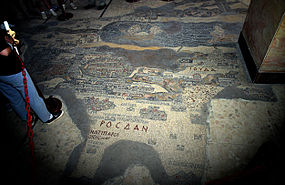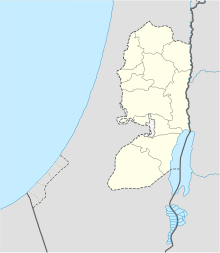- Mamre
-
Mamre 
The Constantine church at Mamre appears on the Madaba Map. Location West Bank Coordinates 31°33′24″N 35°06′19″E / 31.556536°N 35.105336°E History Founded 2600-2000 century BCE Mamre (Hebrew: מַמְרֵא), full Hebrew name Elonei Mamre ("Oaks/Terebinths of Mamre"), refers to a Canaanite cultic shrine dedicated to the supreme, sky god of the Canaanite pantheon, El.[1] Talmudic sources refer to the site as Beth Ilanim or Botnah. it was one of the three most important "fairs", market place or caravanserai, in Palestine. It lies approximately half way between Halhul and Hebron, (heading north from Hebron to Halhul at the intersection of the Halhul/Hebron road and the 3507, one turns right on to the 3507 towards Jericho [away from Bayt Jibrin] and Mamre is to be found some 500 yards further down, on the left).
Contents
History
Bronze age pottery shards found at the site may indicate that the cultic shrine was in use from 2600-2000 BCE.[2] Mamre, in the biblical account, was the site where Abraham came to set up his tents to camp, built an altar,[3] and was brought divine tidings, in the guise of three angels, of Sarah's pregnancy, [4] while elsewhere[5] [6]it is called 'the Terebinths of Mamre the Amorite'.[7][8] Mamre being the name of one of the three Amorite chiefs who joined forces with those of Abraham in pursuit of Chedorlaomer to save Lot. (Gen. 14:13,24)[9][10] The discrepancy is often explained as reflecting the discordance between the different scribal traditions behind the composition of the Pentateuch, the former relating to the Yahwist, the latter to the Elohist recension, according to the documentary hypothesis of modern scholarship.[11]
The enclosure
The ancient well, more than 5 m in diameter, is referred to as Abraham's Well.[12][13] The 2 m thick stone wall enclosing area 60 m wide and 83 m long was constructed by Herod the Great, possibly as a cultic place of worship.[14][15]
The Herodian structure was destroyed by Bar Kochba's army, only to be rebuilt by the Roman Emperor Hadrian. Hadrian revived the fair, which had long been an important one as it took place at an intersection forming the transport and communications nub of transport of the southern Judaean mountains. This mercatus (Heb.yerid or shuq: Gk. paneguris) or fair/market, was one of the sites chosen by Hadrian to sell remnants of Bar Kochba's defeated army into slavery.
Rabbinical tradition
Due to the pagan idolatrous nature of the rituals at the fair, Jews were forbidden to participate by their rabbis.[16][17]
According to the Jerusalem Talmud:
-
'They prohibited a fair only in the case of one of the character of that at Botnah. And it has been taught along these same lines in a Tannaitic tradition. There are three fairs, the fair at Gaza, the fair at Acre, and the fair at Botnah, and the most debased of the lot of them is the fair of Botnah.' [18]
Under Christianity
Notwithstanding the rabbinic ban, by the time of Constantine's reign the market had become an informal interdenominational festival, in addition to its functions as a trade fair, frequented by Christians, Jews and pagans. The cultic shrine was made over for Christian use after Eutropia, Constantine's mother-in-law, visited it and was scandalised by its pagan character. The drawing of the site after the excavation of the German scholar A E Mader from 1926-1928, shows the Basilica and stores furthest from the Haram Ramet el-Khalil, a well altar and tree, with the market place occupying the central enclosure.[19][20] Constantine ordered the comes Acacius to destroy all pagan idols and banned the pagan practises.[21] The enclosure was then consecrated, Constantine had the Basilica built, dedicated to St George and the enclosure of Terebinth of Mamre roofed over, the foundations of which are still visible.[16][22] The venerated tree was destroyed by Christian visitors taking souvenirs, leaving only a stump which survived down to the seventh century.[2][23] The Abraham's angel visitation being revered by the Eastern Orthodox Christians as a pre-figurement of the new testament Holy Trinity.[24] The Constantine church appears on the Madaba Map.
The fifth century account by Sozomen (Historia Ecclesiastica Book II 4-54) is the most detailed account of the practices at Mamre during the early Christian period.[2]
-
-
'The place is presently called the Terebinth, and is situated at the distance of fifteen stadia from Hebron, . . There every year a very famous festival is held in the summer time, by people of the neighbourhood as well as by the inhabitants of more distant parts of Palestine and by Phoenicians and Arabians. Very many come there for the sake of business, some to sell and some to buy. The feast is celebrated by a very big congregation of Jews, since they boast of Abraham as their forefather, of heathens since angels came there, of Christians since he who should be born from the Virgin for the salvation of humankind appeared there to that pious man. Everyone venerates this place according to his religion: some praying God the ruler of all, some calling upon the angels and offering libations of wine, burning incense or sacrificing an ox, a goat, a sheep or a cock... Constantine's mother in law (Euthropia), having come there to fulfill a vow, gave notice of all this to the Emperor. So he wrote to the bishops of Palestine reproaching them for having forgot their mission and permitted such a most holy place to be defiled by those libations and sacrifices.'[25]
-
The monastery on the site continued after Umar's conquest.[26] During the Crusader occupation the site may have been used by the Church of the Trinity.[27][28]
Footnotes
- ^ The king-priest Melchizedek, king of Salem and priest of (El ʿElyon) greets Abraham with bread and wine on his victorious return from battle (Genesis, 14:18-20), located at the modern Ramat al-Khalil. El here is the Canaanite sky god, while Elyon is a distinct deity in what is a compound name. But in Hebrew, the two words meant 'God the Most High'
- ^ a b c Taylor, Joan E. (1993) Christians and the Holy Places: The Myth of Jewish-Christian Origins Oxford University Press, ISBN 0198147856 pp 86-95
- ^ Genesis', 13:18
- ^ Gen.18:1-15
- ^ Genesis 14:13
- ^ David M. Gitlitz & Linda Kay Davidson ‘’Pilgrimage and the Jews’’ (Westport: CT: Praeger, 2006).
- ^ Robert Alter, (tr.) Genesis, W.W.Norton & Co. New York, London 1996 p.60
- ^ Horne, Thomas Hartwell (1856) An Introduction to the Critical Study and Knowledge of the Holy Scriptures Longman, Brown, Green, Longmans & Roberts, p 63
- ^ Watson E. Mills, Roger Aubrey Bullard (1998) Mercer Dictionary of the Bible Mercer University Press, ISBN 0865543739 p 543
- ^ Haran, Menahem (1985) Temples and Temple-Service in Ancient Israel: An Inquiry Into Biblical Cult Phenomena and the Historical Setting of the Priestly School Eisenbrauns, ISBN 0931464188 p 53
- ^ Menahem Haran,Temples and Temple-Service in Ancient Israel: An Inquiry Into Biblical Cult Phenomena and the Historical Setting of the Priestly School, Eisenbrauns, 1985 p.53. The third, Priestly recension excludes any such attachment of Abraham to the Terebinth cult.
- ^ Jericke, Detlef (2003) Abraham in Mamre: Historische und exegetische Studien zur Region von Hebron unhistorische und exegetische Studien zur Region von Hebr BRILL, ISBN 9004129391
- ^ Letellier, Robert Ignatius (1995) Day in Mamre, Night in Sodom: Abraham and Lot in Genesis 18 and 19 BRILL, ISBN 9004102507
- ^ Murphy-O'Connor, Jerome (2008) The Holy Land: An Oxford Archaeological Guide from Earliest Times to 1700 Oxford University Press US, ISBN 0199236666 p 370
- ^ Robinson, Edward (1856) Biblical Researches in Palestine, 1838-52: A Journal of Travels in the Year 1838 pp 215-216
- ^ a b Safrai, Zeev (1994) The Economy of Roman Palestine, Routledge, ISBN 041510243X p 254
- ^ Recent Jewish settlers in the area protest that there was right, now apparently revoked, to visit and worship the site, which they now claim to be a shrine. Inequality and Discrimination in Hebron
- ^ Rabbi Yohanan in the Avodah Zarah, 1:4,39d, cf.Jacob Neusner (tr. & ed.) Abodah Zarah: A Preliminary Translation and Explanation,'University of Chicago Press, 1982 pp.29-30; Ben-Zion Rosenfield, Joseph Menirav, Chava Cassel,Markets and Marketing in Roman Palestine, Brill, 2005 ISBN 9004140492, p.63
- ^ Safrai, Zeev (1994) The Economy of Roman Palestine, Routledge, ISBN 041510243X p 249
- ^ Netzer, Ehud and Laureys-Chachy, Rachel (2006) The Architecture of Herod, the Great Builder Mohr Siebeck, ISBN 316148570X p 231
- ^ Life of Constantine By Eusebius, Translated by Averil Cameron, Stuart George Hall Oxford University Press, (1999) ISBN 0198149174 p 301
- ^ Fergusson, James (2004) Tree and Serpent Worship Or Illustrations of Mythology and Arts in India: In the 1st and 4th Century After Christ Asian Educational Services, ISBN 8120612361 p 7
- ^ Stanley, Arthur Penrhyn (1856) Sinai and Palestine, in Connection with Their History J. Murray, p 142
- ^ Majeska, George P. (1984) Russian Travelers to Constantinople in the Fourteenth and Fifteenth Centuries Dumbarton Oaks, ISBN 0884021017 p 229
- ^ Frazer, James George (2003) Folklore in the Old Testament Studies in Comparative Religion Legend and Law: Studies in Comparative Religion, Legend, and Law Kessinger Publishing, ISBN 0766132382 p 336
- ^ Adamnanus, De Locis Sanctis, 11, 11. 6, CCSL 175, 211.
- ^ Franciscan cyberspot Arbo, also the Terebinth. The Oak of Mambre - (Ramat al- Khalil)
- ^ Denys Pringle, Peter E. Leach(1993) The Churches of the Crusader Kingdom of Jerusalem: A Corpus Cambridge University Press, ISBN 0521390370 p 203
Bibliography
- Adamnanus, De Locis Sanctis
- Alter, Robert (tr.) Genesis, W.W.Norton & Co. New York, London 1996
- Eusebius Life of Constantine, Translated by Averil Cameron, Stuart George Hall Oxford University Press, (1999) ISBN 0198149174
- Fergusson, James (2004) Tree and Serpent Worship Or Illustrations of Mythology and Arts in India: In the 1st and 4th Century After Christ Asian Educational Services, ISBN 8120612361
- Frazer, James George (2003) Folklore in the Old Testament Studies in Comparative Religion Legend and Law: Studies in Comparative Religion, Legend, and Law Kessinger Publishing, ISBN 0766132382
- Haran, Menahem (1985) Temples and Temple-Service in Ancient Israel: An Inquiry Into Biblical Cult Phenomena and the Historical Setting of the Priestly School Eisenbrauns, ISBN 0931464188
- Horne, Thomas Hartwell (1856) An Introduction to the Critical Study and Knowledge of the Holy Scriptures Longman, Brown, Green, Longmans & Roberts
- Jericke, Detlef (2003) Abraham in Mamre: Historische und exegetische Studien zur Region von Hebron unhistorische und exegetische Studien zur Region von Hebr BRILL, ISBN 9004129391
- Letellier, Robert Ignatius (1995) Day in Mamre, Night in Sodom: Abraham and Lot in Genesis 18 and 19 BRILL, ISBN 9004102507
- Murphy-O'Connor, Jerome (2008) The Holy Land: An Oxford Archaeological Guide from Earliest Times to 1700 Oxford University Press US, ISBN 0199236666
- Netzer, Ehud and Laureys-Chachy, Rachel (2006) The Architecture of Herod, the Great Builder Mohr Siebeck, ISBN 316148570X
- Ben-Zion Rosenfield, Joseph Menirav, Chava Cassel,Markets and Marketing in Roman Palestine, Brill, 2005 ISBN 9004140492
- Safrai, Zeev (1994) The Economy of Roman Palestine, Routledge, ISBN 041510243X
- Stanley, Arthur Penrhyn (1856) Sinai and Palestine, in Connection with Their History J. Murray,
- Taylor, Joan E. (1993) Christians and the Holy Places: The Myth of Jewish-Christian Origins Oxford University Press, ISBN 0198147856
- Watson E. Mills, Roger Aubrey Bullard (1998) Mercer Dictionary of the Bible Mercer University Press, ISBN 0865543739
See also
Ancient Christian Commentary on Scripture: Old Testament By Andrew Louth, Thomas C. Oden, Marco Conti Published by InterVarsity Press ISBN 0830814728, pp60-66
Categories:- Hebrew Bible places
- Torah places
- Byzantine Empire
- Eastern Christianity
- Eastern Orthodoxy
- Hebron
- Archaeological sites in the West Bank
- Conversion of non-Christian places of worship into churches
-
Wikimedia Foundation. 2010.


